

|
Soundclip:
|
| See Steve's Hand-Written Solo
Transcription |
|
Steve Khan's solo on: "Criss Cross"(Thelonious Monk) In the world of today's music, and the recording of music, one has the option, and the technology, to put together sophisticated demos of any and all of the proposed songs for an album. As I have grown in this area, "BACKLOG" became the first album where I assembled the demos for all 10 tunes myself. In the past, I've needed help, sometimes, lots of it. 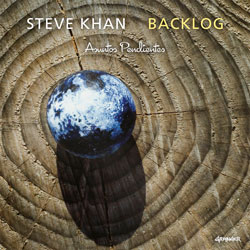 As the detailed work on these demos grew, and they approached being finished, I began to have a sense of the album as a whole. For me, without doing these demos, it would have been incredibly premature to have thought about a sequence for the eventual CD. But, in this case, I was able to do it. I have always believed that the tune that one chooses as the opening track should say something important about the album as a whole. It is as if you are saying, "This is what this album is going to be about!" My initial sequence had Thelonious Monk's "Criss Cross" positioned as Trk. [2]. As time passed, and the recording progressed, that all changed, and I realized that "Criss Cross' would actually be the best possible tune to open the album. Why is that? In many ways, if you look at the 3 most recent recordings, beginning with "PARTING SHOT"(2010), "Criss Cross" is, in concept, the tune most directly connected to that recording, which was simply guitar and Latin percussion, but more than that, it aspired to be Eyewitness meets Latin music head on. With the presence of Anthony Jackson, Dennis Chambers, and Manolo Badrena plus Marc Quiñones and Bobby Allende, all the elements seemed to be in place. I don't know that the recording turned out exactly as I had envisioned it, but, in its way, it was a most important step forward for me. As the detailed work on these demos grew, and they approached being finished, I began to have a sense of the album as a whole. For me, without doing these demos, it would have been incredibly premature to have thought about a sequence for the eventual CD. But, in this case, I was able to do it. I have always believed that the tune that one chooses as the opening track should say something important about the album as a whole. It is as if you are saying, "This is what this album is going to be about!" My initial sequence had Thelonious Monk's "Criss Cross" positioned as Trk. [2]. As time passed, and the recording progressed, that all changed, and I realized that "Criss Cross' would actually be the best possible tune to open the album. Why is that? In many ways, if you look at the 3 most recent recordings, beginning with "PARTING SHOT"(2010), "Criss Cross" is, in concept, the tune most directly connected to that recording, which was simply guitar and Latin percussion, but more than that, it aspired to be Eyewitness meets Latin music head on. With the presence of Anthony Jackson, Dennis Chambers, and Manolo Badrena plus Marc Quiñones and Bobby Allende, all the elements seemed to be in place. I don't know that the recording turned out exactly as I had envisioned it, but, in its way, it was a most important step forward for me.Opening the "BACKLOG" album with "Criss Cross" became the best choice because it was also the most transparent and guitar-centric of all the tunes. I had always loved both of Monk's versions of the tune, the ones that I knew best, which date back as far as 1951, and then, the more recent interpretation from 1963, which also became the title for that Columbia Records album. In addition to those versions, I loved the way the great Kenny Kirkland had interpreted it on his 1991 self-titled CD for GRP Records, but, I had to find a way to separate my interpretation from his - which had been done as a guaguancó. So, with the expert counsel and wisdom of Marc Quiñones, the piece was transformed into what you now hear, fundamentally a son montuno. It is also most important to note that the album begins with the sound of Rubén Rodríguez' Baby Bass, which appears on 7 of the 10 tunes, and forms the basis for the overall sound of the recording. 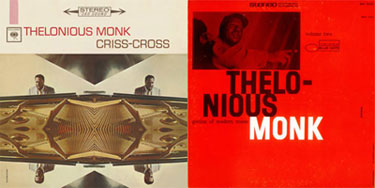 I am especially happy that the album begins by presenting wonderful solos at the end this performance from both Bobby Allende(conga) and Marc(timbal). "Criss Cross" sets up a foundation for the latitude of everything that is to follow. I am especially happy that the album begins by presenting wonderful solos at the end this performance from both Bobby Allende(conga) and Marc(timbal). "Criss Cross" sets up a foundation for the latitude of everything that is to follow.As my concept for an arrangement began to develop, I knew that I wanted to have some kind of guitar-related montuno for the Intro and that would serve as the glue to hold the overall arrangement together. I don't recall exactly how it came to be, probably from just jamming along to the rhythmic feel, but I somehow came-up with an idea that employs the interval of a 10th. Since that 4-bar figure became integral to the piece, it's been amazing to me just how many listeners, musicians amongst them, have asked me if I had played it as two separate parts. No, not at all. Perhaps it's the way that I articulate with the thumb and 2nd finger of my right hand? Though I never thought about it at the time, when I have listened to the performance, it is remarkable how individual each moving voice sounds. With that issue resolved, one other critical structural element remained, what was I going to do about interpreting letter [B]? On Monk's two interpretations of "Criss Cross," each one approaches letter [B] in its own way. The original version plays the section as 8 bars, but the main melodic elements are 2 3-bar phrases, the section concludes with an extra 2 bars added on. The later version plays the bridge as only 6 bars, with only the two 3-bar phrases, and that's it. Kenny Kirkland, while staying in clave played the section as 6 bars. For my arrangement, I chose to use 8-bars, and made two 4-bar phrases, adding an extra bar to the end of each 3-bar phrase. When one is speaking about great interpretations of the music of Thelonious Monk, and beyond that, great Latin-style interpretations of Monk's music, 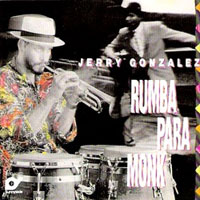 if you have not ever heard "RUMBA PARA MONK" by Jerry Gonzalez' Fort Apache Band from 1988, then you must immediately seek it out, and spend some time with it. It goes without saying that, I just LOVE this album. And, Kenny Kirkland's version of "Criss Cross" included Ft. Apache integral members Andy & Jerry González and Steve Berrios. if you have not ever heard "RUMBA PARA MONK" by Jerry Gonzalez' Fort Apache Band from 1988, then you must immediately seek it out, and spend some time with it. It goes without saying that, I just LOVE this album. And, Kenny Kirkland's version of "Criss Cross" included Ft. Apache integral members Andy & Jerry González and Steve Berrios.Another element that must be considered when one is playing Latin Jazz is, how are the various choruses of any solo going to be shaped and shaded by the rhythm section. If one looks to the timbal, there are often 3 sonic and/or dynamic layers for any song or solo. Often times, a timbalero begins by playing cáscara or paila on the shells of the timbal. If the song has a traditional 32-bar form, as "Criss Cross" does, when the tune hits the [B] section, the timbal usually goes to the mambo or Salsa bell, where it is joined by the campana from the bongocero. After that section is where a problem can occur, once the player has gone to that higher level, it can feel strange for them to return to playing cáscara for [A3], so knowing this, I had a discussion about these issues during the rehearsal with Marc Quiñones in order to map out just how we would approach this 4-chorus solo, trying to keep it ascending in intensity. What we decided to do was this. In the first 3 choruses, Marc would stay on the mambo bell for both [B] and [A3], returning to cáscara for [A] and [A2]. Then, in Chorus 4, everything would open-up, and he would be on the mambo bell throughout the entire chorus. For my recordings, there is also one other vital rhythmic element, and that is the inclusion of a full drum kit, and on "BACKLOG" these duties were handled superbly by Mark Walker. Here the issue is a bit similar but different, and his choices must work well with my concepts, and fit-in with the timbal, conga, and bongo. The question becomes, when would Mark shift from the basic hi-hat groove to the ride cymbal, and when would he then just stay there? For me, the key issue is when should he go to the ride cymbal for the 1st time? I felt that the best thing for the way that I conceived of the shape of this particular solo was that, he would stay away from the ride cymbal until letter [B] of Chorus 3, and then, if he chose to, he could just stay on the ride cymbal for all of Chorus 4. Even though this concept might have felt strange to these great players, they were terrific about going along with what I felt would be the best and most musical course of action to take, and I am most grateful to Marc, Bobby, Rubén, and Mark for that. Chorus 1 begins with a chordal sonority that becomes a thematic device throughout. On the guitar, we often see voicings that cross over the top 4 strings as being related to one chord family or another. I'm referring to chord shapes that could be considered as minor 7th or dominant 7th in nature. In a case like this, where the first 4 bars of "Criss Cross" are over Gm7, which is usually a G Dorian [G, A, Bb, C, D, E, F] area, a keyboard player will just use his chordal colors, and see everything as minor, no matter what extensions or scale degrees might be included in any one particular voicing. In sharp contrast to that, a guitarist might view the shapes that he is employing in a most different way. The first chordal voicing that I played, spelling up Bb-E-A-D, is often viewed as a C7(9/13) chord, but to a pianist, it's just Gm7(9/6). I often associate this kind of sonority as being part of McCoy Tyner's approach to harmony, and this has to include all those players that he influenced, like Herbie Hancock and Chick Corea. It's the inclusion of the E-natural that gives this kind of chord voicing its special character. From those first 2 bars of [A], the single-note lines appear employing notes from G Dorian, and then, for me, F Dorian [F, G, Ab, Bb, C, D, Eb] over the Bb7 chord. In bar 6, that phrase is punctuated, by left hand voicings that McCoy might play in such a situation. Bars 7-8 conclude the section with further chordal work in the same style. It should be noted that, because of the overall format of the arrangement, for this solo section, what would normally be labeled as A-A-B-A became: [C]-[C2]-[D]-[C3] for each chorus. [C2] begins with a variation on the principal chordal theme, and shifts to G minor pentatonic [G, Bb, C, D, F] lines. Over the Bb7 chord the lines are derived from F Dorian. The final two bars are approached thematically from using the minor pentatonic based upon the 6th degree of each chord. So, over the G7(13) you see E minor pentatonic [E, G, A, B, D] and over Gb7(13) that becomes Eb minor pentatonic [Eb,Gb, Ab, Bb, Db]. But in each case the root of the chord is avoided. As [D] arrives, the bridge, the linear approach continues to come from a very pentatonic perspective. You have two 4-bar phrases: | Cm7 / / / | F7(alt.) / / / | Bbmaj7 / / / |Dbm7 / Gb7 / || Over the Cm7, the line is from G minor pentatonic. Over the F7 chord, the line is from Db dominant 7th pentatonic [Db, Eb, F, Ab, Cb] with a touch of chromaticism. Over Bbmaj7, you have D minor pentatonic [D, F, G, A, C]. And over Dbm7-Gb7, the line really comes from Db Dorian [Db,Eb, Fb, Gb, Ab, Bb, Cb]. The 2nd 4 bars begin with a Cm7(sus) chordal punctuation in the Tyner style. This time over the F7, the Ab minor pentatonic [Ab, Cb, Db, Eb, Gb] is applied, and this choice gives us all of the altered tones: Ab(#9), Cb/B(b5), Db/C#(#5), and Gb(b9). Once again, over the Bbmaj7 chord you have D minor pentatonic. The last bar, over Dbm7-Gb7, has another typical Tyner-esque chord punctuation. [C3] continues in a chordal vein with voicings that I associate with Chick Corea and the way that he was playing Latin music in the '60s, best exemplified by his work on Cal Tjader's 1966 "SOUL BURST"(Verve) album. The remaining 2 bars over Gm7 are approached using D minor pentatonic. 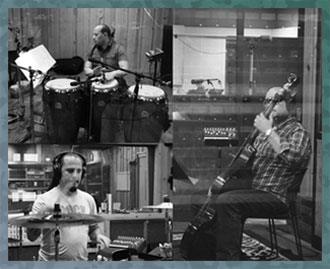 Over the Bb7 chord, one could say that the lines are coming from F melodic minor [F, G, Ab, Bb, C, D, E]. The final chordal punctuations over bars 7-8 have a touch of Chick Corea, and even some Wes Montgomery. Over the Bb7 chord, one could say that the lines are coming from F melodic minor [F, G, Ab, Bb, C, D, E]. The final chordal punctuations over bars 7-8 have a touch of Chick Corea, and even some Wes Montgomery.A classic G minor montuno becomes the centerpiece as Chorus 2 arrives. It enters on the and-of-4, and that accented emphasis continues throughout the 8 bars. As E-natural(6th) is a featured note, it plays a role that continues through the Bb7 chord, and the G7 chord as well, but there, it is added in via the open top E-string. The montuno continues through the first 2 bars of [C2] and finally, single-note lines reappear putting G Dorian to use again, but with a line configuration that skips the Bb. Over the Bb7, you have an arpeggio that spells out Bb7(9/13) with a touch chromaticism at the end, and that is again punctuated by 4-note chords, very much in the "SOUL BURST" style. The section concludes in bars 7-8 with a line configuration in 6ths that employs a particular string-skipping idea that seems to appear in my playing with some degree of regularity. Continuing on in the upper register, letter [D] and the ii-Vs in Bb major begin with a descending arpeggio that emphasizes an F augmented triad, which certainly goes back to the pre-Be-Bop years of the genre. Arriving at the cadence in bar 3 of Bbmaj7, a long winding line starts off with something that I like to do, and that is to surround my target note of D-natural(3rd) with its chromatic upper(Eb) and lower(C#) neighbors, before descending through bars 3-4 and arriving on an Eb, as the Cm7 chord arrives again in bar 5. The line reascends via an arpeggio, and when it hits the F7(alt.) chord, it descends passing through a b5 substitute that is somewhere between using B dominant 7th pentatonic [B, C#, D#, F, Ab] and F# Dorian [F#(b9), G#(#9), A, B(b5), C#(#5), D#, E]. By now, the altered tones that these options provide should be obvious. This long line eventually cadences to an F-natural(5th) over the Bbmaj7 chord. Over bar 4, and Dbm7-Gb7, the line descends yet again through somewhere between Db Dorian and Eb minor pentatonic, and leads us right down to a Bb(m3rd) as bar 1 of the next section arrives. [C3] of Chorus 2 begins with a breath, that is followed by upper register, at least on the guitar, chordal punctuations, again in the same pianistic style. Then, in bars 3-4, another long descending line begins with a similar upper-lower neighbor configuration, but this time targeting D-natural, the 5th of Gm7. Notice that, as the line cadences to Bb7 in bar 4, instead of approaching the target note of Ab(7th) from above, the prior line goes down to G-natural, and then comes up a 1/2-step to the Ab. That closing phrase is punctuated by chords that echo what was played some 4 bars earlier. I think that this a good time to point out a particularly important phrasing concept that I try to be mindful of when playing, and that is intended to conclude phrases that end with 2 8th-notes utilizing long-short phrasing. I believe that when a player does this, especially horn players, the rest of the band picks up the sense of swing from that small detail. If you haven't been doing this, now might be a great time to try incorporating it into your own playing!!! Through bars 7-8 as the chorus comes to close, over the descending chords G7(13) to Gb7(13), just down one 1/2-step, the line reflects that movement by taking an idea and repeating it just up one 1/2 step. So, over the G7(13), I'm playing D minor pentatonic, and over the Gb7(13), I then play Eb minor pentatonic. Two different approaches, one 1/2-step apart, but one employs the minor pentatonic built upon the 5th degree, and following one is built upon the 6th degree. All of these ideas appear in my book "PENTATONIC KHANCEPTS" As the solo continues into Chorus 3, the motif becomes something that I have referred to in the past as the doubled-note effect, which is really derived from the saxophone technique of using an alternate fingering to play the exact same note. On the guitar, depending upon the wing-span of your left hand, usually this is accomplished by playing the note on your G-string, and then playing the same note on your B-string. When one is writing this out, you usually use a plus sign(+) above the repeated note. In this case, the phrase is played in bars 1 & 3, and each of those phrases is answered by chordal punctuations. As the Bb7 chord arrives in bar 5, there is a held Bb7(13b5) voicing played, which was augmented by my overdubbed Strat with the tremolo arm, and a volume pedal swell. I have often referred to this technique as a guitar orchestration. The idea is that it is either ghosting the harmony played, or adding a couple extra voices to it. Either way, it is most effective when gently tucked behind the principal guitar! Bar 7 adds a single note line in response using the F melodic minor again. Bars 7-8 follow with double-stop motifs through each of the two chords, and giving a continuity to this section. [C2] begins by combining chord voicings in the Tyner and "SOUL BURST" style, putting to use parallel harmonies under a melodic top voice. The first chord in bar 2, with an Eb on top, is not really in the mode of G Dorian, however, I am just thinking of that pitch as a chromatic upper neighbor to D-natural(5th). Bars 3-4 answer with a return of the doubled-note effect, and chordal punctuations that extend the ideas expressed in bars 2 & 4 of [C]. In bars 5-6, now over Bb7, the doubled-notes continue, as they have now moved up a 1/2-step to accommodate the chord change. After the chordal punctuations in bar 6, bars 7-8 offer a lush sonority over the G7(13) chord, adding in the b5(C#/Db), and this sound shape continues through bar 8 just one 1/2-step lower. The first 4 bars of letter [D] offer more lines derived from the application of pentatonics. Bar 1, over the Cm7, puts to use a bit of both the C minor pentatonic [C, Eb, F, G, Bb] and D minor pentatonic. Over the F7(alt.), you will find the Db dominant 7th pentatonic. Bar 3 operates somewhere between the Bb major scale and D minor pentatonic. 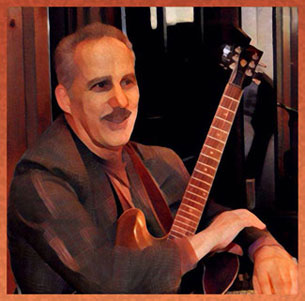 Bar 4 begins with a piece of Db minor pentatonic, but slides up a 1/2-step to G-natural-D natural, which is a way of hinting at a G7 chord to turn us around to Cm7 in the following bar. Bars 5-6 offer chordal sonorities that begin with Cm7(sus) sounds, and those change to F7(alt.) sounds, but because we're going to a I major7 chord, all options are on the table with regards to the altered notes, so here you see both the b5(B-natural) and the b9(Gb). Bars 7-8 conclude the section, while putting to use a mini-montuno utilizing major triads over the Bbmaj7, both F major and G major, and over Dbm7-Gb7, both Fb major and Gb major. If the bassist is observing the roots and 5ths of the chords in his playing, these kinds of sonorities can sound huge, considering how simple they actually are. You just have to hear things well above the root, that's the key!!! Bar 4 begins with a piece of Db minor pentatonic, but slides up a 1/2-step to G-natural-D natural, which is a way of hinting at a G7 chord to turn us around to Cm7 in the following bar. Bars 5-6 offer chordal sonorities that begin with Cm7(sus) sounds, and those change to F7(alt.) sounds, but because we're going to a I major7 chord, all options are on the table with regards to the altered notes, so here you see both the b5(B-natural) and the b9(Gb). Bars 7-8 conclude the section, while putting to use a mini-montuno utilizing major triads over the Bbmaj7, both F major and G major, and over Dbm7-Gb7, both Fb major and Gb major. If the bassist is observing the roots and 5ths of the chords in his playing, these kinds of sonorities can sound huge, considering how simple they actually are. You just have to hear things well above the root, that's the key!!![C3] of Chorus 3 begins with the highest chord voicing played during this solo, and again, it's very much in the same chordal/harmonic style, and rhythmically speaking, very much in the 2:3 clave. The single-note lines pick-up in bar 3 using the upper/lower neighbor idea, but this time they surround the 9th(A-natural) of the G Dorian mode, and descending through the C dominant 7th pentatonic [C, D, E, G, Bb]. More chromaticism appears in both bars 4 and 5 as the chord changes to Bb7. You might notice the hopefully subtle inclusion of E-natural(b5) in bar 6. The chorus concludes with further chordal punctuations which seek to expand the harmony while following the chord movement from G7(13) to Gb7(13). If it needs to be said, the integration of lines and chordal punctuations, each with equal melodic content, has been something that I have been working on, and striving for in my playing for the longest time. Listening back, after some time has passed, this particular solo becomes a good example of what I have sought to do. With the rhythm section now hitting on all cylinders, Chorus 4 begins with a line over the Gm7 harmony that is derived from the C dominant 7th pentatonic that goes through the full 4 bars. As the Bb7 chord arrives in bar 5, the line takes on a motif rooted in rhythm that extends into the chord change to G7(13). Over the Gb7(13) the line puts to use a common shape for Db Dorian, and once again, the last two notes Eb & Db chromatically surround the target note of D-natural, which hits on the downbeat of [C2]. Here again, the principal chordal sonorities, that go back to the very beginning of the solo, reappear giving a continuity to the shape of the entire solo. Bar 5, over the Bb7, features one of my favorite harmonic devices, one that I sometimes like to refer to as the sideways Richard Tee approach. What that means is that, I am playing a very common R&B/Gospel oriented keyboard idea for any dominant 7th chord, but playing it a b5 away from the root. So, here you have a C#m triad going down to a Bm triad sitting hard on the quarter notes, and then, in bar 6, this resolves to the more consonant and traditional, Gm triad to an Fm triad over the Bb7. When played with a sense of irony, this is a great sound - IF one hears things this way! Bar 7, over G7(13), follows with the usage of E minor pentatonic, while in bar 8, over Gb7(13), this is followed with an upper register Dbm7(9) sweep downwards ending on Db-Cb-Db which, once again, surrounds the target note of D-natural by its chromatic upper and lower neighbors. The aforementioned D-natural(9th) arrives on bar 1 of the final [D] section and the Cm7 chord as part of the ii-V to Bbmaj7. From there, in bar 2, over the F7(alt.) chord, the B dominant 7th pentatonic is applied, and in bar 3, over Bbmaj7, once again, D minor pentatonic is the choice, and a favorite of mine over major 7th chords, because you always get the pretty color tones of the 6th(G) and the 9th(C). In bar 4, over the Dbm7-Gb7, the line comes from Gb dominant 7th pentatonic [Gb, Ab, Bb, Db, Fb]. As the ii-V starts up again in bar 5, here, with a dash of chromaticism, you have F dominant 7th pentatonic [F, G, A, C, Eb], as the key note to include is the A-natural over the Cm7. Over the F7(alt) in bar 6, Db dominant 7th pentatonic appears. Finally, in bar 7, as we cadence to Bbmaj7, I played a D major triad (D-F#-A) over that chord which resolves to the more consonant note of C-natural(9th). You could view this device as a delayed F7(13b9) sound, as a D triad is also a part of that sonority. As the bridge section closes out, there is a chordal punctuation featuring parallel 7sus voicings from Dbm7(sus). The last section of the solo, [C3] and the 4 bars of Gm7 feature one last return to our basic chordal soundshapes approach to the entire solo. Again, on the guitar, you could view these sounds as a mixture between sophisticated C7 voicings and Gm7 voicings with the harmonic extensions. This style of playing and applying it to Latin music, for me, and I know that I am repeating myself, comes from Chick Corea's acoustic piano approach as heard on "SOUL BURST" from 1966. The final 4 bars of this section offers an arranged reprise of those same 4 bars from the [A3] section of the melody. The twist here, as percussion solos are coming, is that I arranged the section to modulate to Am7 so that we would not be in the same tonal area for the entire piece. So, in bar 8, you see and hear, E7(#9#5) setting up the montuno a whole-step above where we have been. Preceding the wonderful solos by Bobby Allende(conga) and Marc Quiñones(timbal) is a fantastic "break figure," which was created by Marc and Bobby, and beautifully executed with the participation of Rubén Rodríguez and drummer Mark Walker. I love hearing this break each time I listen to this performance. These details are the very things that Marc, Bobby and Rubén contributed to all the arrangements that give the music its sabor Latino, and I am so grateful to the guys for these classic touches. Throughout the course of the discussion of this particular solo, I have spoken about the usage of various pentatonic ideas, and how they were put to use over the various chord changes and progressions found in this great Thelonious Monk tune. What I probably should have mentioned is that one of the reasons that I find these linear devices so appealing is that they are never too far away from the blues language that, in my opinion, one always wants to have as a part of their playing. 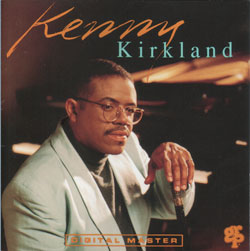 If you look at G minor pentatonic [G, Bb, C, D, F] and the G blues scale [G, Bb, (B), C, Db, D, F], you really only find the Db, a blue note, as the fundamental difference. However, in the end, one's playing is always a personal mix of everything musical and non-musical that ever drifted through their life prior to playing that day - you never know what's going to come out. This was true for players of my generation, reared during the '50s and '60s, but it is even more true today for the generation of players coming up during If you look at G minor pentatonic [G, Bb, C, D, F] and the G blues scale [G, Bb, (B), C, Db, D, F], you really only find the Db, a blue note, as the fundamental difference. However, in the end, one's playing is always a personal mix of everything musical and non-musical that ever drifted through their life prior to playing that day - you never know what's going to come out. This was true for players of my generation, reared during the '50s and '60s, but it is even more true today for the generation of players coming up during If I can, I would love to say a few words about Kenny Kirkland who sadly left us all too soon. What a great, great player, a really hard swingin' player he was. For the longest time, his interpretation of Wayne Shorter's "Ana Maria" was my favorite tune on his solo CD for GRP. I still listen to it often, and find it to be very romantic and inspiring at the same time. The tunes with a Latin influence remain some of the best on the album, and, of course, "Criss Cross" and Bud Powell's "Celia" were a couple of them, and Kenny sounds so wonderful on all of them. If I have piqued your interest please check out Kenny Kirkland on this recording!!! Though I have written this before, perhaps it bears repeating? One of the most fascinating aspects in the lives of contemporary musicians is that we can go into a recording having actually heard reasonable facsimiles of our song selections in demo form. And sometimes, those demos can be excellent. So, believe it or not, with a bit of time before "BACKLOG" was recorded in April of 2016, I actually thought that I knew the sequence of the album. Imagine that, as a group, we had not played a single note of this music together. Each artist has his or her own way of arriving at a sequence, and, as comical as it might be to some, most men want to come out of the gate hitting it hard. So, the first tune is often at a brisk tempo, and then other shadings and colors follow with the subsequent tunes. Of course, one must always consider the various tempos, the keys or tonal areas, the moods of the pieces, etc., but for me, I always want the opening tune to serve as a good representation of what the whole project is about. This is obviously a Latin Jazz album, with its roots in the guitar trio format, and, as I stated when this analysis began, "Criss Cross" became the best possible opening tune. Of course, I have a core group of friends, some musicians, some not, with whom I always share a new recording to get an honest sense of just what I might have created. One of the most fascinating aspects of allowing people to hear the album in full before its release is that it helps to give me a sense of what some trusted people are responding to. It was fascinating that a few people told me that they would have opened the album with "Head Start"(Bobby Hutcherson) or "Invisible"(Ornette Coleman). To be honest, I was amazed by that. You just never know!!! As we have now finally arrived at March, 2017, my hope is that anyone and everyone who somehow hears this recording will somehow connect with the music and carry it with them for a long, long time. I wish that I had the slightest idea of just where the USA is now headed.
[Photos: Marc Quiñones-Bobby Allende-Rubén Rodríguez Collage by Adela Blanco
@ Avatar Studios, April, 2016 Steve Khan Photo by: Richard Laird @ Avatar Studios Prisma® Treatment by: Adela Blanco |